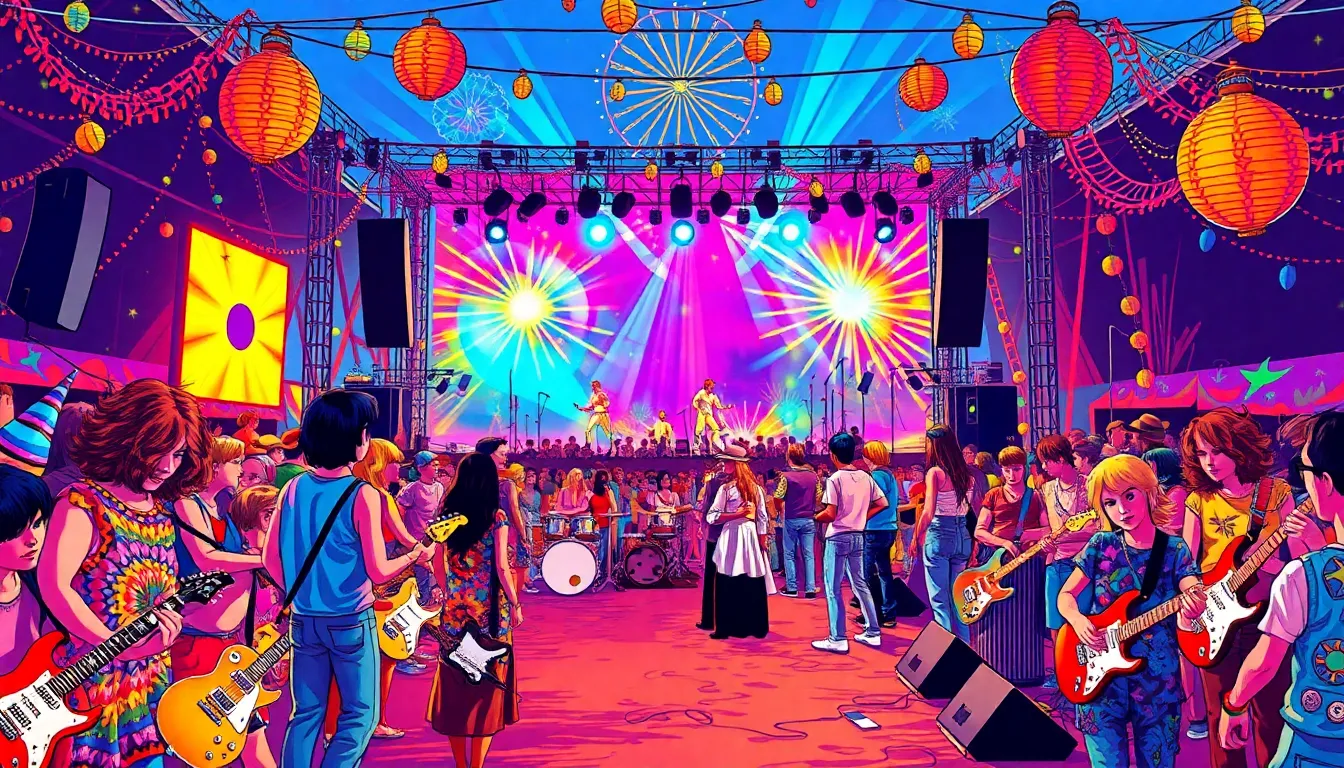Table of Contents
TogglePsychedelic rock isn’t just a genre; it’s a wild trip through sound, color, and consciousness. Emerging in the 1960s, this musical movement took listeners on a rollercoaster of mind-bending experiences, fueled by experimental sounds and vivid imagery. Think of it as a musical kaleidoscope where the ordinary transforms into the extraordinary, and every note invites you to explore uncharted territories of the mind.
With bands like The Beatles and Pink Floyd leading the charge, psychedelic rock became the soundtrack for a generation seeking liberation from the mundane. It’s a genre that encourages you to let go, embrace the weird, and dance like no one’s watching—even if your cat is judging you from the corner. So buckle up as we dive into the colorful world of psychedelic rock, where every riff is a journey and every lyric is a portal to a new dimension.
Overview of Psychedelic Rock
Psychedelic rock emerged in the 1960s as a transformative genre that pushed musical boundaries. This genre offers listeners unique experiences through its experimental sounds and vivid imagery. Iconic bands like The Beatles and Pink Floyd played pivotal roles in defining this movement. They created soundscapes that served as a soundtrack for a generation exploring liberation and adventure.
Musical elements characteristic of psychedelic rock include reverb-laden guitars, unconventional song structures, and extended instrumental segments. Lyrics often incorporate surrealistic themes, reflecting altered states of consciousness. These features contribute to a mesmerizing auditory experience.
A notable aspect of psychedelic rock is its connection to the counterculture movement of the 1960s. As society embraced new forms of expression, this genre became a vehicle for ideas about peace, love, and self-discovery. Festivals like Woodstock highlighted psychedelic rock’s role in uniting people and promoting social change.
Fans of psychedelic rock appreciate its eclectic mix of influences. Musicians often drew inspiration from Eastern philosophies, jazz improvisation, and avant-garde art. This blend of styles resulted in a diverse body of work, encouraging creative exploration.
Psychedelic rock continues to influence contemporary music today. Modern artists often incorporate elements from this genre, showcasing its enduring legacy. As a result, new generations discover the eccentricity and richness of psychedelic rock, finding solace in its journeys into altered consciousness.
Historical Context

Psychedelic rock emerged as a defining genre in the 1960s, deeply intertwined with the cultural revolution of the time. Bands began experimenting with new sounds, pushing musical boundaries.
Origins in the 1960s
Psychedelic rock’s roots trace back to the mid-1960s, influenced by earlier rock and roll, blues, and folk music. The use of electric instruments, particularly the electric guitar, transformed the soundscape. Innovative recording techniques, such as tape manipulation and reverb, played a vital role in creating its signature sound. Iconic tracks like “Lucy in the Sky with Diamonds” by The Beatles exemplified this new direction. Additionally, the genre was characterized by fluid song structures and improvisational elements, drawing on earlier jazz influences.
Cultural Impact and Counterculture
Psychedelic rock resonated strongly with the counterculture movement of the 1960s. It acted as a voice for youth seeking liberation from societal norms. Live performances at festivals, such as Woodstock, cemented its cultural significance. Iconic lyrics frequently addressed themes of peace, love, and self-exploration, aligning with the era’s values. The genre also promoted the exploration of altered states of consciousness through music, encouraging communal experiences. Such milestones established psychedelic rock as a catalyst for social change and artistic expression.
Key Characteristics of Psychedelic Rock
Psychedelic rock features distinct musical and lyrical elements that create an immersive experience for listeners. This genre’s unique sound and themes define its cultural significance within the 1960s.
Musical Elements
Reverb-laden guitars dominate the soundscape of psychedelic rock. Unconventional song structures often deviate from standard rock formats. Extended instrumental segments showcase improvisation and experimentation. Innovative recording techniques, such as tape manipulation, contribute to its signature auditory effects. Influential tracks like “A Day in the Life” by The Beatles exemplify this complexity while incorporating orchestral flourishes. The genre encourages exploration through its eclectic mix of influences, including blues, folk, and Eastern music traditions.
Lyric Themes
Surrealistic themes and altered states of consciousness frequently surface in psychedelic rock lyrics. Lyrics often convey messages of peace, love, and self-exploration, resonating with listeners during the counterculture movement. Many songs reflect vivid imagery and dreamlike narratives. Iconic examples include “The End” by The Doors, which captures existential themes within an alluring poetic structure. This focus on the inner psyche invites listeners to journey through emotional landscapes. Ultimately, the genre’s lyrical depth mirrors its eclectic sound, enhancing its transformative power.
Influential Psychedelic Rock Artists
Several artists led the psychedelic rock movement, each leaving a lasting impact on the genre and music at large.
The Beatles
The Beatles played a crucial role in shaping psychedelic rock. Their 1967 album, Sgt. Pepper’s Lonely Hearts Club Band, showcased innovative soundscapes and experimental songwriting. Tracks like “Lucy in the Sky with Diamonds” featured surreal lyrics and orchestral arrangements, pushing musical boundaries. Inspired by the counterculture of the 1960s, their work resonated with a generation seeking change. Collaborations with producers like George Martin introduced groundbreaking studio techniques. The band’s ability to blend pop sensibilities with avant-garde elements created a distinct style that influenced countless artists.
Pink Floyd
Pink Floyd is frequently hailed as a pioneer of psychedelic rock. Their album, The Piper at the Gates of Dawn, released in 1967, encapsulated the essence of the genre through experimental sounds and storytelling. Songs like “Astronomy Domine” featured intricate arrangements and immersive sonic textures. The band’s exploration of themes such as existentialism and mental health made their music deeply relatable. Live shows, characterized by elaborate visual displays, transformed the concert experience. By consistently pushing creative limits, Pink Floyd crafted an enduring legacy within the psychedelic movement.
Jimi Hendrix
Jimi Hendrix revolutionized rock guitar with his distinctive style. His iconic track, “Purple Haze,” exemplified the fusion of blues and psychedelic elements. Hendrix’s innovative use of feedback and distortion created a soundscape unheard of at the time. Live performances, such as his set at Woodstock, showcased his virtuosic skills and charisma. With songs like “All Along the Watchtower,” he redefined songwriting conventions, infusing them with a sense of urgency. Hendrix’s bold demeanor and groundbreaking techniques continue to inspire musicians across genres.
Evolution and Legacy
Psychedelic rock has undergone significant transformations since its inception.
Revival in the 1990s and 2000s
The 1990s saw a resurgence of interest in psychedelic rock, with many bands drawing inspiration from the genre’s classic sounds. Groups like The Flaming Lips and Tame Impala revived psychedelic elements, blending them with alternative and indie rock styles. The Flaming Lips’ album The Soft Bulletin showcased lush soundscapes characteristic of 1960s psychedelia. Tame Impala’s Lonerism offered a modern twist on the genre, featuring dreamy instrumentals and introspective lyrics. These artists reintroduced the hallucinogenic experience to a new audience, fostering a fresh exploration of sound.
Modern Interpretations
Contemporary musicians continue to reinterpret psychedelic rock, creating innovative sounds that reflect today’s culture. Bands such as MGMT and Pond embody this modern take, merging genres and incorporating electronic influences. MGMT’s tracks often feature surreal lyrics and vibrant melodies, capturing the essence of psychedelic experimentation. Pond, with their dynamic performances, blends traditional rock elements with a contemporary aesthetic. These artists push creative boundaries, ensuring psychedelic rock remains relevant. Their work attracts both old fans and a new generation eager to explore the genre’s evolution.
Psychedelic rock stands as a vibrant testament to a transformative era in music and culture. Its innovative soundscapes and rich lyrical content invite listeners on a journey of self-discovery and exploration. The genre’s ability to blend diverse influences ensures its continued relevance in today’s music scene.
As contemporary artists draw inspiration from its legacy, psychedelic rock evolves while retaining its core essence. This genre not only shaped the musical landscape of the 1960s but also continues to inspire new generations, encouraging a deeper connection to art and consciousness. The legacy of psychedelic rock will undoubtedly endure, captivating hearts and minds for years to come.




